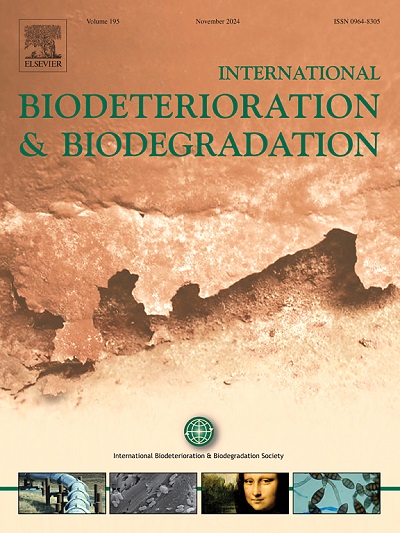去除微藻生物膜的水凝胶精油:用于石材遗产保护的应用策略
IF 4.1
2区 环境科学与生态学
Q2 BIOTECHNOLOGY & APPLIED MICROBIOLOGY
International Biodeterioration & Biodegradation
Pub Date : 2025-05-24
DOI:10.1016/j.ibiod.2025.106128
引用次数: 0
摘要
本研究面临着开发新的生态友好型杀菌剂和有效的应用策略以减轻文化遗产中光营养性生物肥料的迫切需要。为了解决这一挑战,以前从罗马斗兽场(罗马,意大利)的地下收集的一种微藻菌株被用来诱导莱切石标本上的生物膜形成。分别用0.5%和1%的百里香、牛根和肉桂精油处理样品。将EOs包封在海藻酸盐水凝胶支撑基质(HG)中,并以不同的应用时间(24 h和48 h)作用于生物膜。使用mini-PAM便携式荧光计测定治疗后2个月的光合活性。扫描电镜观察EOs对生物膜内微藻细胞形态的影响,傅里叶变换红外光谱分析处理后生物分子分布的变化。研究结果表明,所有EO在HG中都是有效的。然而,在监测期结束时,只有肉桂EO保持了光合抑制,特别是在0.5%的浓度下施用48小时时。此外,肉桂EO处理的生物膜表现出最显著的作用,特别是在破坏细胞膜和减少脂质信号,最终导致细胞裂解。这种方法在规定的时间内使用低浓度的EO,有效地抑制了石头表面形成生物膜的光养生物的活力。本文章由计算机程序翻译,如有差异,请以英文原文为准。

Essential oils in hydrogel for microalgal biofilm removal: Application strategies for stone heritage preservation
This study faces the critical need to develop new eco-friendly biocides and effective application strategies to mitigate phototrophic biodeteriogens in cultural heritage sites. To address this challenge, a microalgal strain previously collected from the hypogeum of the Colosseum (Rome, Italy) was used to induce biofilm formation on Lecce stone specimens. The samples were treated with 0.5% and 1% of essential oils (EOs) from Thymus vulgaris L., Origanum vulgare L. and Cinnamomum verum Presl. The EOs were encapsulated in an alginate hydrogel support matrix (HG) and applied to the biofilms with different application times (24 h and 48 h). A mini-PAM portable fluorometer was used to determine the phototrophic activity up to 2 months after treatment. Scanning electron microscopy was used to investigate the effects of EOs on microalgal cell morphology within biofilms, while Fourier transform infrared spectroscopy analyzed changes in biomolecular distribution after treatment. The findings revealed that all EOs were effective when encapsulated in HG. However, by the end of the monitoring period, only cinnamon EO maintained photosynthetic inhibition, especially when applied at 0.5% for 48 h. Moreover, biofilm treated with cinnamon EO showed the most significant effects, particularly in disrupting cell membranes and reducing lipids signals, ultimately leading to cell lysis. This approach effectively inhibited the vitality of biofilm-forming phototrophs on stone surfaces, using low concentrations of EO for defined periods of time.
求助全文
通过发布文献求助,成功后即可免费获取论文全文。
去求助
来源期刊
CiteScore
9.60
自引率
10.40%
发文量
107
审稿时长
21 days
期刊介绍:
International Biodeterioration and Biodegradation publishes original research papers and reviews on the biological causes of deterioration or degradation.

 求助内容:
求助内容: 应助结果提醒方式:
应助结果提醒方式:


